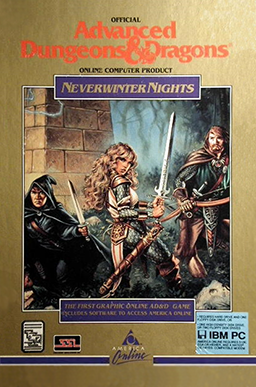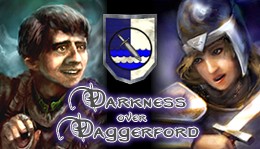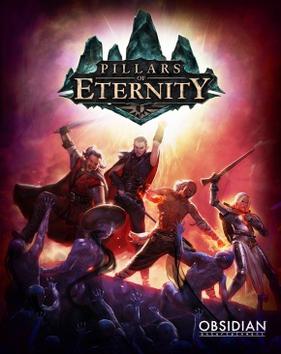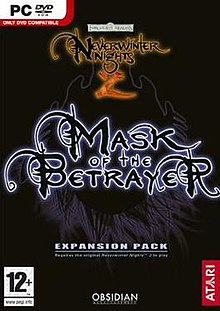
Baldur's Gate is a series of role-playing video games set in the Forgotten Realms Dungeons & Dragons campaign setting. The series has been divided into two sub-series, known as the Bhaalspawn Saga and the Dark Alliance, both taking place mostly within the Western Heartlands, but the Bhaalspawn Saga extends to Amn and Tethyr. The Dark Alliance series was released for consoles and was critically and commercially successful. The Bhaalspawn Saga was critically acclaimed for using pausable realtime gameplay, which is credited with revitalizing the computer role-playing game (CRPG) genre.

Neverwinter Nights is a third-person role-playing video game developed by BioWare. Interplay Entertainment was originally set to publish the game, but financial difficulties led to it being taken over by Infogrames, who released the game under their Atari range of titles. It is the first installment in the Neverwinter Nights series and was released for Microsoft Windows on June 18, 2002. BioWare later released a Linux client in June 2003, requiring a purchased copy of the game to play. MacSoft released a Mac OS X port in August 2003.

The Elder Scrolls III: Morrowind is an open-world action role-playing video game developed by Bethesda Game Studios and published by Bethesda Softworks. It is the third installment in The Elder Scrolls series, following 1996's The Elder Scrolls II: Daggerfall, and was released in 2002 for Microsoft Windows and Xbox. The main story takes place on Vvardenfell, an island in the Dunmer province of Morrowind, part of the continent of Tamriel. The central quests concern the demigod Dagoth Ur, housed within the volcanic Red Mountain, who seeks to gain power and break Morrowind free from Imperial reign.

Baldur's Gate II: Shadows of Amn is a role-playing video game developed by BioWare and published by Interplay Entertainment. It is the sequel to 1998's Baldur's Gate and was released for Microsoft Windows in September 2000. Following its predecessor, the game takes place in the Forgotten Realms, a fantasy campaign setting, and is based on the Advanced Dungeons & Dragons 2nd edition rules. Powered by BioWare's Infinity Engine, Baldur's Gate II uses an isometric perspective and pausable real-time gameplay. The player controls a party of up to six characters, one of whom is the player-created protagonist; the others are certain characters recruited from the game world.
Obsidian Entertainment, Inc. is an American video game developer based in Irvine, California. It was founded in June 2003, shortly before the closure of Black Isle Studios, by ex-Black Isle employees Feargus Urquhart, Chris Avellone, Chris Parker, Darren Monahan, and Chris Jones.

Minsc is a fictional character in the Baldur's Gate series of Dungeons & Dragons role-playing video games developed by BioWare and Larian Studios. He originated from the pen-and-paper Dungeons & Dragons sessions held by the lead designer of Baldur's Gate, James Ohlen, and was expanded upon by the game's lead writer, Lukas Kristjanson. His video game debut was in Baldur's Gate as a companion character who can join the player's party. He also appears in the sequel, Baldur's Gate II: Shadows of Amn, the expansion, Baldur's Gate II: Throne of Bhaal, the 2015 game Baldur's Gate: Siege of Dragonspear, the 2023 game Baldur's Gate 3, as well as in promotions relating to the titles. Minsc is voiced by Jim Cummings in his original video game appearances, and by Matt Mercer in Baldur's Gate 3.

Icewind Dale II is a role-playing video game developed by Black Isle Studios and published by Interplay Entertainment, released on August 27, 2002. Like its 2000 predecessor Icewind Dale, the game is set in the Forgotten Realms fantasy setting in the Icewind Dale region. The player assumes control of a group of mercenaries in a war between the Ten Towns of Icewind Dale and a coalition of persecuted races and religions.

Neverwinter Nights 2 is a role-playing video game developed by Obsidian Entertainment and published by Atari Interactive. It is the second installment in the Neverwinter Nights series and is the sequel to BioWare's Neverwinter Nights, based on the Dungeons & Dragons fantasy tabletop role-playing game. Neverwinter Nights 2 utilizes an adaptation of the Dungeons & Dragons 3.5 edition rules. Players create player characters to represent themselves in the game, using the same character creation rules as found in the Dungeons & Dragons game. They may gain the assistance of additional party members, and they eventually acquire a keep that can be used as a base of operations. Neverwinter Nights 2 is set in the Forgotten Realms campaign setting—in and around the city of Neverwinter. The story is mostly unrelated to Neverwinter Nights and follows the journey of an orphaned adventurer investigating a group of mysterious artifacts known as "silver shards" and their connection to an ancient, evil spirit known as the King of Shadows.

Neverwinter Nights: Shadows of Undrentide is an expansion pack for Neverwinter Nights developed by Floodgate Entertainment and BioWare, and was released in June 2003. The expansion pack adds a new campaign and new features including new character classes, creatures, feats, and spells, and other nuances such as allowing the player to access and modify their henchman's inventory. The Windows version also included scripting options for the Aurora toolkit.

Neverwinter Nights was an early graphical multiplayer online role-playing game, which ran from 1991 to 1997 on AOL.

Neverwinter Nights: Hordes of the Underdark is an expansion pack for the role-playing video game Neverwinter Nights produced by BioWare and published by Atari. The follow-up to the Shadows of Undrentide expansion, Hordes of the Underdark adds a campaign, prestige classes, and other features. The Windows version also includes new scripting options for the Aurora toolkit.

Neverwinter Nights 2: Mysteries of Westgate is an expansion pack for the role-playing video game Neverwinter Nights 2. It was developed by Ossian Studios and published by Atari Interactive on April 29, 2009. The player creates a character and controls it, along with a group of three pre-designed companions, journeying through the game world. The gameplay is very similar to that of the base game. Mysteries of Westgate also includes new monsters, music, and other tools, which can be used by players to create their own Neverwinter Nights 2 levels.

Neverwinter Nights 2: Storm of Zehir is an expansion pack for the role-playing video game Neverwinter Nights 2, developed by Obsidian Entertainment and published by Atari Interactive. It was released in late 2008 in North America, Europe, and Australia. Like previous entries in the Neverwinter Nights series, Storm of Zehir is based on the paper and pencil fantasy role-playing game Dungeons & Dragons, and uses the game's 3.5 edition ruleset.

Darkness over Daggerford is a premium module for BioWare's Neverwinter Nights role-playing video game. It was released for digital distribution on August 16, 2006. Considered a user-made mod, the game was created by Canadian company Ossian Studios, headed by former BioWare employee Alan Miranda. It was remastered and released as an official premium module on June 1, 2018.

Neverwinter Nights is a series of video games developed by BioWare and Obsidian Entertainment, based on the Forgotten Realms campaign setting of the Dungeons & Dragons role-playing game. Aside from also being set around the city Neverwinter, it is unrelated to both the 1991 Neverwinter Nights online game and the 2013 online game called Neverwinter.

Neverwinter is a free-to-play massively multiplayer online role-playing game developed by Cryptic Studios for Microsoft Windows in 2013, Xbox One in 2015, and PlayStation 4 in 2016. Based on the fictional Forgotten Realms city of Neverwinter from Dungeons & Dragons, Neverwinter is a standalone game and not part of the previous Neverwinter Nights series.
Western role-playing video games are role-playing video games developed in the Western world, including The Americas and Europe. They originated on mainframe university computer systems in the 1970s, were later popularized by titles such as Ultima and Wizardry in the early- to mid-1980s, and continue to be produced for modern home computer and video game console systems. The genre's "Golden Age" occurred in the mid- to late-1980s, and its popularity suffered a downturn in the mid-1990s as developers struggled to keep up with changing fashion, hardware evolution and increasing development costs. A later series of isometric role-playing games, published by Interplay Productions and Blizzard Entertainment, was developed over a longer time period and set new standards of production quality.

George Ziets is an American video game designer best known as the Creative Lead for the 2007 PC game Neverwinter Nights 2: Mask of the Betrayer.

Pillars of Eternity is a role-playing video game developed by Obsidian Entertainment and published by Paradox Interactive. It was released for Microsoft Windows, OS X, and Linux on March 26, 2015. The game is a spiritual successor to the Baldur's Gate and Icewind Dale series, along with Planescape: Torment. Obsidian started a crowdfunding campaign on Kickstarter for it in September 2012. The campaign raised over US$4 million, which was the highest funded video game at the time. The game uses the Unity engine.

Annie VanderMeer is an American video game designer specializing in role-playing video games, best known for her narrative work on 2021's Unpacking and her design work on the 2012's Guild Wars 2.



















